This easy, Super-Soft Playdough recipe with Cream of Tartar that lasts for weeks! Have lots of fun and play for hours with this soft, moldable playdough!
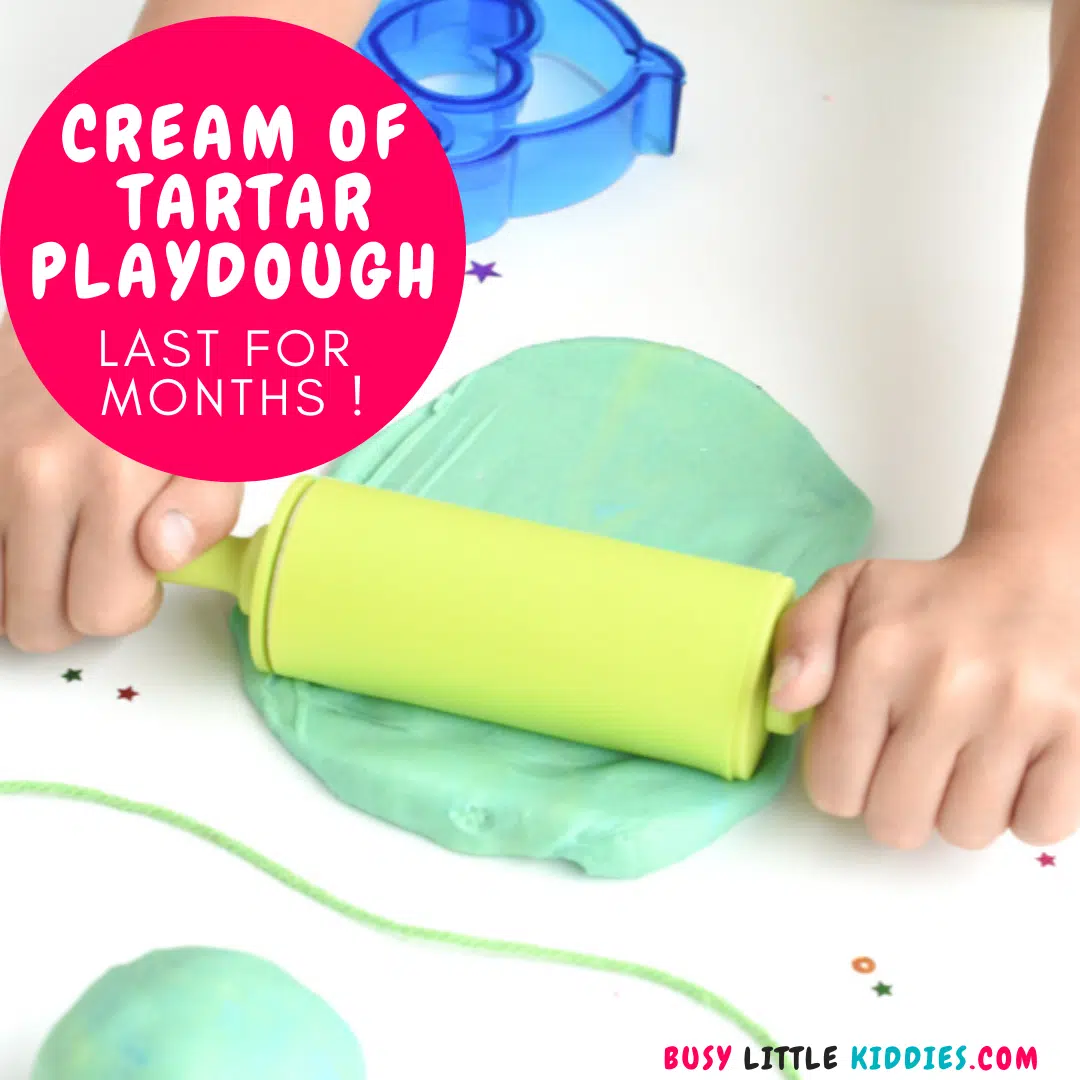
Cream of tartar gives a super soft texture to playdough recipes. Scientifically, cream of tartar is an acid, which means it stabilizes recipes like meringue or makes playdough last longer.
Ingredients and Substitutions
The ingredients you need to make the best playdough recipe with cream of tartar are basic pantry ingredients you probably have at home. I listed below my tips on how to choose them, for the full recipe jump to the recipe at the bottom of this post:
- All-purpose flour – regular white wheat flour. Spoon the flour from the bag using a measuring cup, slightly pack and level up. This is very important, or you may add too much flour and your playdough end up dry.
- Salt – it acts as a stabilizer, don’t skip it, or the dough wouldn’t last, and the texture wouldn’t be the same.
- Oil – any vegetable oil work in this recipe. I love coconut oil; it has antibacterial properties and a lovely coconut smell.
- Cream of tartar – this makes the playdough recipe last longer. See below for alternatives.
- Food coloring – I love to use drops rather than powder. It provides shiny colors.
- Essential oil – optional, but I love to add lavender to play dough. It smells good, and it’s relaxing.
- Boiling water – use a kettle or saucepan to bring water to a high boil. It’s crucial to use boiling water, or the gluten in the flour wouldn’t activate and come together.
Cream of tartar is an acidic chemical compound added in playdough recipe to create a soft, texture as store bought play doh brand. To make playdough without cream of tartar, replace it by another acid solution like:
- Lemon juice – lemon juice is liquid, so it will dilute the playdough consistency. It means that you will have to decrease the amount of water in your playdough recipe by the volume of juice added to the dough. It means that if the recipe calls for 2 tablespoons of cream of tartar and 1 cup of water, replace with 2 tablespoons of lemon juice and use only 3/4 cup + 2 tablespoons of water.
- Kool-Aid – many playdough recipes use a Kool-Aid mix instead of cream of tartar. Kool-Aid is a powder used to make flavored drinks and it contains many acidic components that act as the cream of tartar including citric acid and ascorbic acid.
How To Make Playdough With Cream of Tartar
There are two ways to make playdough with cream of tartar and oil. Some recipes cook the playdough in a saucepan – not my favorite as it often stick to the pan. Another easy way to make playdough is to use boiling water and that’s the recipe I am sharing here. This uncooked playdough with cream of tartar is much easier to make and only requires a bowl and a spatula.
- First, bring the water to boil in a kettle or saucepan. Meanwhile, combine the dry ingredients into a large mixing bowl.
- Stir in the 2 cups of flour, salt, and cream of tartar. Then, make a well in the center, add food coloring and vegetable oil, and gradually pour the hot water, stirring as you go with a silicone spatula.
- The dough will be sticky and elastic at first. Keep stirring then wait a few minutes for the dough to cool and knead the dough with your hands.
- You can also make the dough in a stand mixer using the dough hook attachment.
- If the dough is too sticky, add a bit more flour.
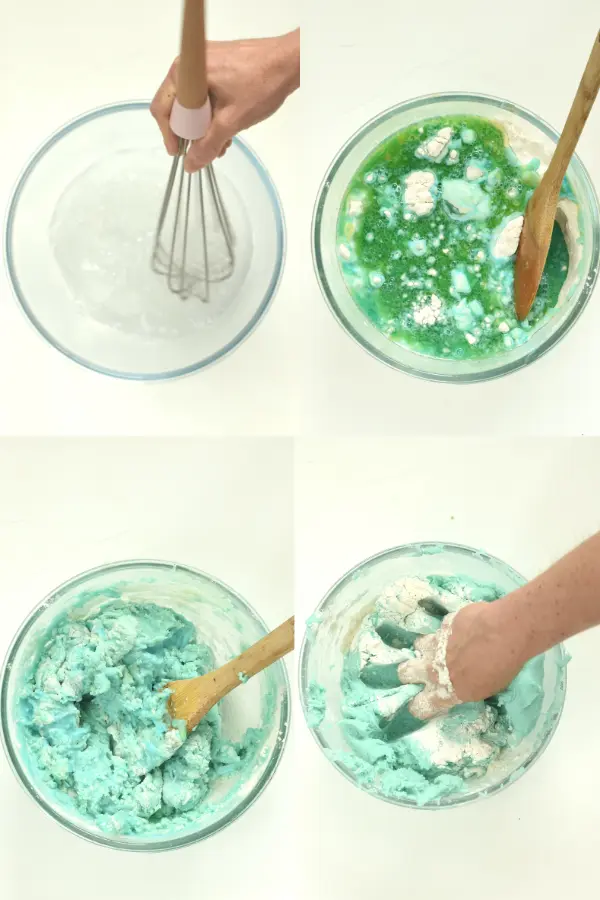
Using Cream of Tartar Playdough
This is a great sensory dough for kids sensory play activities of any age. This playdough is a great recipe to roll, cut shapes with a cookie cutter, or shape playdough animals or elements.
Your kids will be playing for a long time with this dough, creating stories and games like pretend-to-cook and make a cupcake shop or barbecue with friends.
You can also use this recipe to make sensory bins, like in my dinosaur sensory bin project.
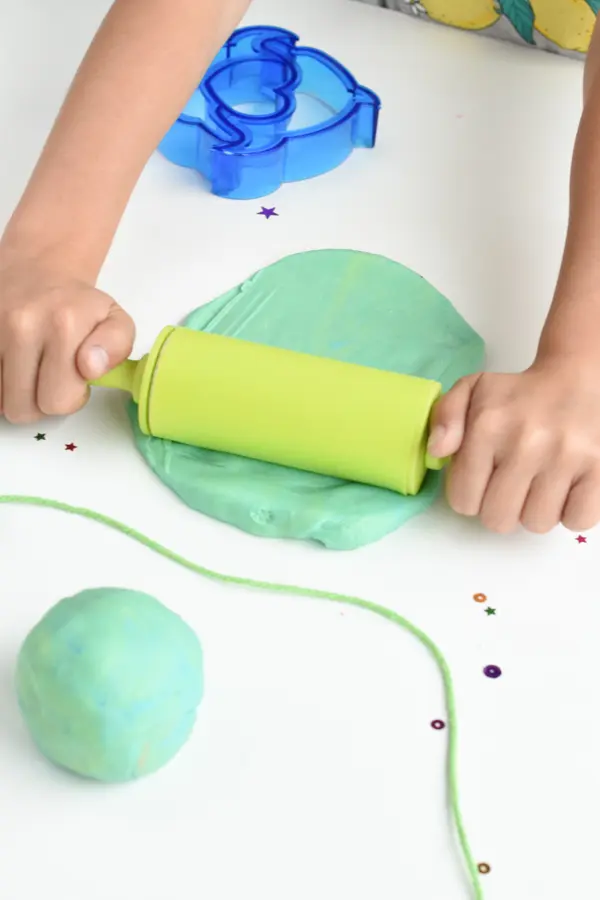
The Science Behind Playdough
Making playdough is simple chemistry and if your kids are a bit older, they may want to understand how it works. When you combine boiling water with flour, the heat activates the gluten in the flour. Gluten is a protein, like egg white, and like any protein, it hardens when it gets in contact with heat. The longer you mix it, the tougher it gets.
However, playdough is a soft, moldable dough. So to avoid the dough turning hard as a rock, you need to add a few ingredients to your playdough. To make playdough soft and elastic you need to add a lubricant, oil, and acid to emulsify the dough – which meaning that the ingredients will blend easily.
Now you probably wonder why adding salt in playdough? Well, salt acts as a preservative, it makes the dough last longer, and it also adds texture to the dough. Finally, the oil and cream of tartar make the dough super soft and moldable.
Storage Instructions
This playdough contains cream of tartar and salt, so it lasts up to 3 weeks in an air-tight container. Playdough doesn’t like moisture, so don’t store it in the fridge or an open container. To reuse this playdough days after days, read my tutorial on how to fix dry playdough.
More playdough recipes
If you love making playdough with your kids too, I have a few more recipes for you to try on the blog!
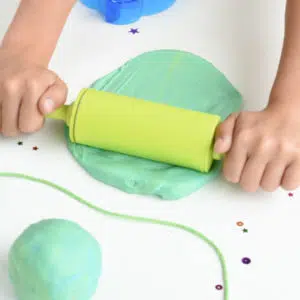
Playdough Recipe with Cream of Tartar
Materials
- 2 cups All-Purpose Flour spoon, slightly packed, level up
- ½ cup Salt
- 2 tablespoons Cream of tartar
- 2 tablespoons Oil of choice I used coconut oil
- ½ teaspoon Food coloring
- 1 ¼ cup Boiling water
Extra flour to adjust the dough
- 1-3 tablespoons All-Purpose Flour
Instructions
- In a kettle or small saucepan, bring water to boil.
- Measure the amount of boiling water required by the recipe and place it in a large bowl with salt. Whisk quickly to combine – not all the salt will dissolve, and that's ok. Set aside while you prepare the remaining ingredients.
- In another large mixing bowl, combine the flour and cream of tartar.
- Make a well in the center of the flour and pour the oil and hot water/salt mixture.
- Stir with a spatula. The dough will be very sticky at first, and then it becomes difficult to stir, so use your hand to knead the dough. If it's still too hot, wait a few minutes to avoid burning yourself.
- If the dough is too sticky, dust 1 extra tablespoon of flour and vigorously knead on a for 1 minute. As the dough cools down and absorbs the extra flour, it becomes super soft and less sticky.
- When you manage to form a ball, transfer to a lightly floured work surface and keep kneading to cool it down, dusting extra flour if needed until it reaches your favorite texture.
- Repeat the recipe to create different colors. Add sprinkles or essential oil if desired.



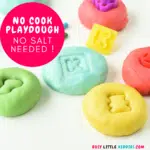

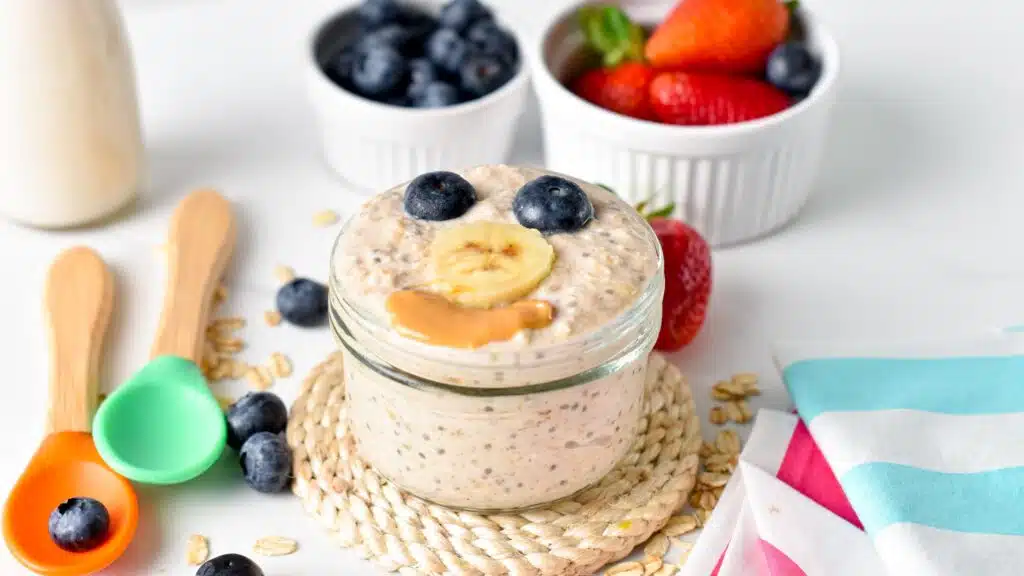
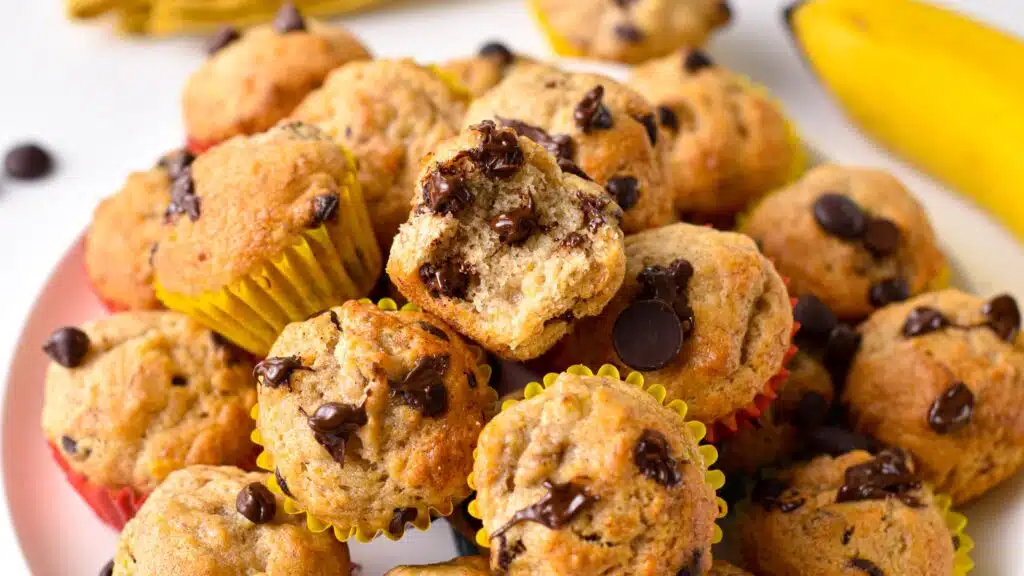
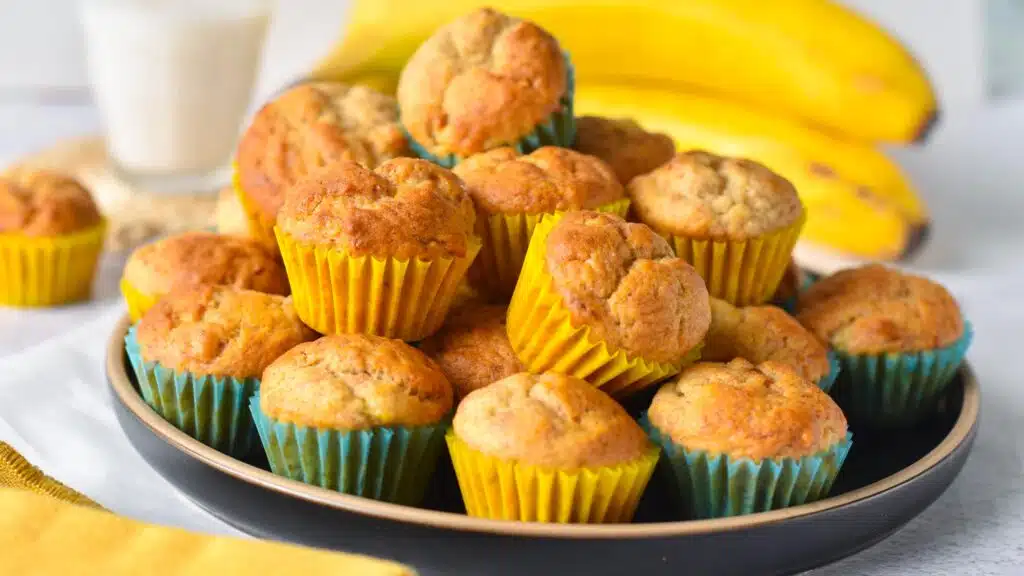
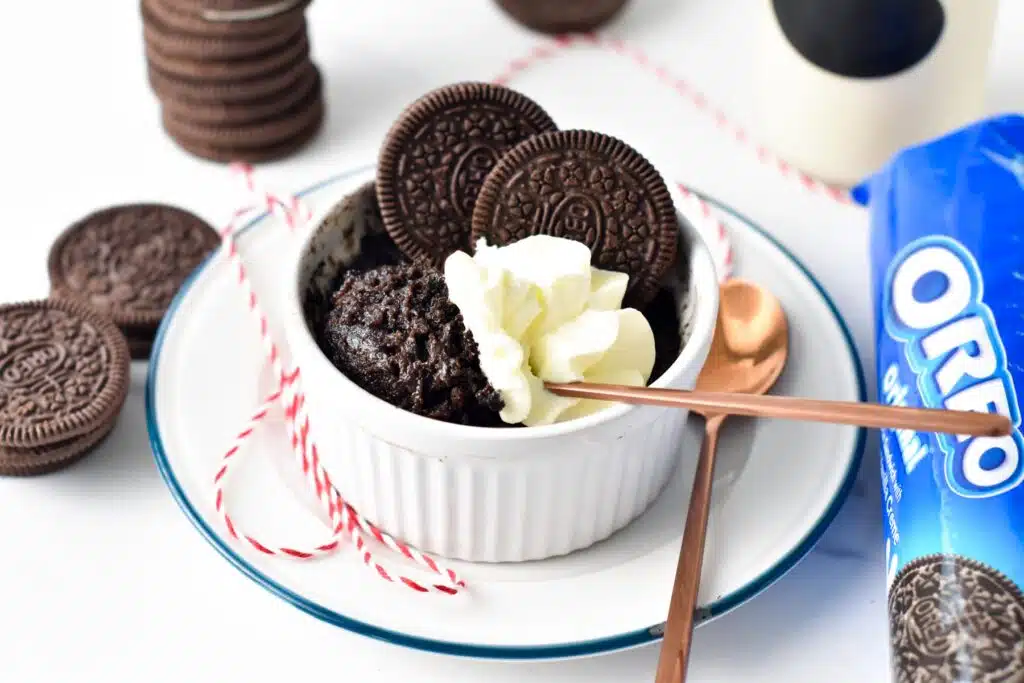
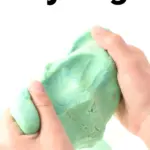

Hi I tried the recipe and it turns out great but I get a salty/gritty feeling on my hands after a few minutes of playing. Do you have any tips to make it a bit more oily vs gritty? Thanks!
Try using very fine salt. Salt can sometimes aggregate in the mixture, so the finer the better!
My toddler and I made this this morning. It was a fun, slightly messy of course, and quick activity to do together. We made 1/2 a recipe since we only had one cup of flour left in the house and that is still a generous amount! Came together quickly and loved that we didn’t have to cook it. Thank you for sharing!